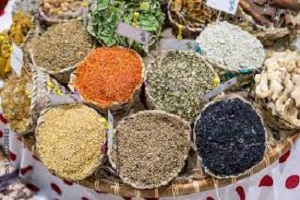Indian Snakeroot Benefits for High Blood Pressure, More
Indian Snakeroot Benefits for High Blood Pressure & More. Please watch.
- Indian Snakeroot Benefits for High Blood Pressure, Kidney, diabetes and side effects.
- What are the Uses and Health Benefits of Indian Snakeroot (Rauwolfia Serpentina)?
- Sarpagandha – Uses, Benefits, Side Effects, Precautions & More!
What exactly is Indian Snakeroot (Rauwolfia Serpentina)?

The Indian snakeroot plant, Rauwolfia serpentina, has a long history as a therapeutic plant that predates the development of Ayurvedic medicine.
The history of this plant is really intriguing. Master Charak identified this herb, also known as sarpagandha, as a helpful remedy for snakebite and insect stings.
In India’s ancient Ayurvedic medicine, Indian snakeroot has mostly been used to treat high blood pressure and mental diseases including schizophrenia and anxiety.
Additionally, reserpine, a prescription medication, and one of the compounds in Indian snakeroot are identical.
Rauwolfia is an evergreen shrub and member of the Apocynaceae family. It features tiny pink or white flowers and spherical, glossy, black, or purple fruits.
Because it is used in both conventional and modern systems of medicine, this plant species warrants great care.
Sarpagandha is regarded in Ayurveda as a whole plant and not just the alkaloid reserpine.
- Family: Apocynaceae
- Botanical Name: Rauwolfia serpentina
- English Name: Indian snakeroot, Rauvolfia root, serpentine root
- Hindi Name: Chota chand, Nayi, Nakulikand, Rasna
- Sanskrit Name: Chandramara, Dhaavati
Common Names
- Indian Snakeroot
- Rauwolfia
- Sarpagandha
Other Name(s):
African Snake Root, Ajmaline, Arbre aux Serpents, Arbre de Serpents, Bois de Couleuvre, Chandrika, Chota-Chand, Covanamilpori, Dhanburua, Pagla-Ka-Dawa, Ophioxylon serpentinum, Patalagandhi, Racine de Couleuvre, Racine de Serpent, Rauwolfia, Rauwolfae Radix, Rauwolfia Serpentina, Serpiria, Rauwolfiawurzel, Rauvolfia serpentina, Sarpagandha, Sarpgandha, Serpentaire de l’Inde, Serpentine, Serpentine-Wood, Serpiria,
Overview
Indian snakeroot is a plant and medicine is made from the root.
The plant is used to treat mental illnesses such as agitated psychosis and insanity, as well as mild high blood pressure, anxiety, and sleeplessness.
Indian snakeroot is also used as a tonic for general debilities and for snake and reptile bites, fever, constipation, feverish intestinal problems, liver disorders, achy joints (rheumatism), fluid retention (edema), and epilepsy.
It has a chemical that is similar to the prescription medication reserpine. Reserpine is used to treat schizophrenia, mild to severe hypertension, and a few signs of impaired circulation.
How does it function?
Chemicals in Indian snakeroot include reserpine, a prescription drug used to treat high blood pressure.
Indian Snakeroot Benefits – what are the Medicinal Qualities of Rauwolfia Serpentina?
- Rasa (Taste): Bitter
- Veerya (Potency): Hot
- Effect on Tridosha: It balances Vata and Kapha doshas.
- Guna (Qualities): Dry
- Vipaka: Undergoes pungent taste after digestion
Which Part of the Plant is used for the Medicinal Purpose?
The herb’s roots are used as medicine because they have the largest concentrations of active ingredients that help reduce anxiety and have calming, anti-hypertensive, and anti-anxiety benefits. The seeds and powder are also used as medicines
The Chemical Constitution of Rauwolfia Serpentina
It contains Ajmalicidine, Ajmalicine, Rouhimbine, Indobinine, Reserpiline, Aricine, Rescinnamidine, Isoreserpine, Indobine, Serpentinine, Yohimbine, etc.
The main active constituent of Rauwolfia serpentina is Reserpine. Reserpine is well known for its anti-hypertensive and anti-psychotic action.
What are the Medicinal Properties of Rauwolfia Serpentina?
- Anti-hypertensive
- Anti-inflammatory
- Hypnotic
- Anti-diuretic
- Anti-anxiety & proliferative
- Sedative
- Anti-microbial
What are the Therapeutic Indications of Rauwolfia Serpentina?
- High-Grade fever as it reduces fever and feeling of restlessness and discomfort
- Snakebite
- The uncontrolled outburst of fear and emotions
- A Whooping cough
- High Blood pressure (Hypertension)
- Insomnia (Sleeplessness)
- Intestinal Worms
- Diarrhea
- Dysentery
- Abdominal pain due to constipation
- Hangover due to excessive alcohol intake
- Uterine pain after miscarriage
The Medicinal Uses of Rauwolfia Serpentina
Reserpine is an indole alkaloid that has anti-hypertensive and tranquilizing properties is given to patients with hypertension in the form of a root paste mixed with rose water and rock candy.
Anxiety and stress
Chewing the root of Indian snake wood can instantly calm the mind and relieve tension and anxiety because it alters bodily hormones that can relax the mind and ease the symptoms of these conditions.
Stomach Comfort
It is used to cure diarrhea and constipation, cleanses the stomach and supports regular functioning, and relieves constipation due to its soothing impact.
It has been used as an effective treatment for gastrointestinal stress for thousands of years.
Anti-inflammatory Qualities
Its ability to reduce inflammation has been recognized for ages.
Because of its anti-inflammatory properties, it is used to treat any type of inflamed wound, including snake bites and insect bites.
It can effectively relieve pain and inflammation in the affected area as well as neutralize the poisons of various bites and venoms.
Due to its anti-inflammatory properties, it is also a successful treatment for tendonitis, gout, and arthritis.
Additionally, it is known to lower fever.
Menstrual Problems
Additionally, Indian snakeroot eases menstruation pain.
This plant provides a simple remedy for ladies who struggle with painful menstruation.
In addition to having anti-inflammatory and mood-regulating qualities, it induces menstruation.
The typical symptoms of menstruation, such as cramping, bloating, and mood changes, can be eliminated.
It also eases uterine pain that develops after a miscarriage. The uterus’ inability to remove the leftovers from the uterine cavity is what causes pain.
Sarpagandha increases uterine muscular contractions, which aid in the removal of toxins from the uterine cavity.
Skin Conditions
The herb sarpagandha is effective in treating a number of skin conditions, including urticaria. Urticaria is frequently characterized by severe itching.
As a natural anti-bacterial and anti-fungal agent, this herb can be used to cure skin infections, which is why sarpagandha is frequently used to treat boils, acne, eczema, and cellulitis.
Insomnia
The herb sarpagandha has sedative qualities. As a result, it helps to alleviate insomnia.
The usage of this herb can effectively manage the mental hyperactivity that results in sleeplessness. It has a slightly hypnotic effect that aids in inducing sleep.
What are the Other Uses of Rauwolfia Serpentine?
The root of Sarpagandha is also used to increase uterine contraction to facilitate or ease childbirth.
The root of Sarpagandha is also used to increase uterine contraction to facilitate or ease childbirth and its decoction is used to treat boils and pimples.
- The juice of Sarpagandha leaves is instilled into the eyes as a remedy for the removal of opacities of the cornea.
- The juice or decoction of this plant is used as an effective medicine in treating hysteria and epilepsy.
Uses & effectiveness
Insufficient Evidence to Rate Effectiveness for…
Trouble sleeping (insomnia): Early evidence shows that Indian snakeroot in an exact mixture with two other herbs might help insomnia.
- Nervousness
- Mental disorders such as schizophrenia
- Constipation
- Spasms in the legs due to poor circulation
- Mild high blood pressure
Other Conditions
- Fever
- Liver problems
- Joint pain
How to Use Sarpagandha?
Sarpagandha is accessible in three forms:
Your Ayurvedic physician will recommend you the form and dosage as per your health condition.
- Sarpagandha powder
- Sarpagandha capsule
- Sarpagandha Ghan Vati
Before taking any herbal supplements, you must seek the advice of a licensed physician. Without first consulting a licensed physician, never stop or substitute an ongoing modern medical treatment with an ayurvedic/herbal preparation.
To evaluate Indian snakeroot’s efficacy for these uses, more data are required.
What are the Side Effects of Rauwolfia serpentina?
The majority of reserpine’s side effects are brought on by its effects on C.N.S sedation, which is more significant in rare cases of psychotic depression that might result in suicide.
It shouldn’t be used if you have an ulcer, hyperacidity, renal problems, or bronchial asthma.
This herb should not be consumed during pregnancy or right after giving birth because it stimulates the uterus, and it should not be used to treat depression because it stimulates the uterus.
Precautions & Warnings to Be Taken with Sarpagandha:
Sarpagandha consumption may be safe if done in moderation and in accordance with normal safety guidelines.
For the following circumstances, sarpagandha may have some harmful effects:
- Use of sarpagandha during pregnancy and breastfeeding is not advised due to the possibility of birth abnormalities caused by the medication’s components. These substances may harm the unborn child if they get into breast milk as well.
Sarpagandha is not advised if you have gallstones because it could make them worse.
- Ulcerative colitis and stomach ulcers: Sarpagandha is not advised in these cases because it may exacerbate the illness.
- Allergy to alkaline reserpine: If you are allergic to reserpine or drugs with a similar effect, you should not take sarpagandha.
- When beginning electroconvulsive therapy, it is important to cease taking sarpagandha a week in advance.
- Surgery – Sarpagandha is said to interfere with surgical procedures by raising blood pressure and heart rate. As a result, it’s imperative to cease taking the medication at least two weeks before the surgery.
- Depression – Sarpagandha can cause depression, especially in those who have already experienced it.
- Diabetes: Indian snakeroot can lower blood sugar levels. It may result in too low blood sugar levels when coupled with other diabetes drugs.
Please refrain from attempting to treat yourself by taking herbs. Although there may be possible health benefits from using Ayurvedic herbs, it is best to speak with a trained Ayurvedic doctor before doing so.
Serpentina Leaves Tea Benefits
Serpentina leaves, also known as Sarpagandha or Indian snakeroot, come from the plant Rauwolfia serpentina. This plant is native to the Indian subcontinent and has been traditionally used in Ayurvedic medicine for various purposes. Serpentina leaves are particularly known for their potential health benefits, especially when brewed into tea. Here are some of the potential benefits associated with serpentina leaves tea:
- Blood Pressure Regulation: Serpentina leaves contain alkaloids such as reserpine, which have been found to have hypotensive (blood pressure-lowering) effects. This makes serpentina tea potentially beneficial for individuals with high blood pressure.
- Stress and Anxiety Reduction: Some studies suggest that compounds found in serpentina leaves may have anxiolytic (anti-anxiety) effects. Drinking serpentina tea might help in reducing stress and anxiety levels.
- Sleep Aid: Due to its calming effects, serpentina tea is sometimes used as a natural remedy for insomnia or sleep disturbances. It may help promote relaxation and improve sleep quality.
- Migraine Relief: Traditional medicine practices often use serpentina leaves for managing migraines and headaches. The vasodilatory properties of certain compounds in serpentina may help alleviate migraine symptoms.
- Antioxidant Properties: Serpentina leaves contain antioxidants that can help protect cells from damage caused by free radicals. Antioxidants are important for overall health and may play a role in reducing the risk of chronic diseases.
- Anti-inflammatory Effects: Some research suggests that serpentina leaves may possess anti-inflammatory properties, which could be beneficial for conditions involving inflammation, such as arthritis.
- Digestive Health: In traditional medicine, serpentina leaves are sometimes used to improve digestion and alleviate gastrointestinal discomfort.
- Potential Anticancer Properties: There is ongoing research into the potential anticancer properties of compounds found in serpentina leaves. Some studies suggest that certain alkaloids present in serpentina may have cytotoxic effects on cancer cells.
It’s important to note that while serpentina leaves tea has potential health benefits, it’s essential to consume it in moderation. As with any herbal remedy, it’s advisable to consult with a healthcare professional, particularly if you have any underlying health conditions or are taking medications, to ensure it’s safe for you. Additionally, more research is needed to fully understand the effects and potential side effects of serpentina tea.
People also ask
What is the benefit of snakeroot?
Indian snakeroot is a plant. The root is used to make medicine.
It is used to treat minor hypertension, anxiety, sleeplessness, and mental illnesses such as agitated psychosis and insanity.
What is Indian snakeroot used for?
The constituent medicinal ingredient that lowers high blood pressure: The root contains reserpine, a potent sedative alkaloid compound.
Although this plant is most famous for its ability to lower blood pressure, Indian folk medicine also uses it as a treatment for mental illnesses.
When is the best time to take serpentina?
600 mg per day, given about an hour before bedtime, is the normal dosage.
People who use rauwolfia should be watched for the potential start of depressive symptoms since this substance lowers monoamine activity.
Habitat of Rauvolfia Serpentine
Along with Thailand, this plant can also be found in India, Pakistan, Sri Lanka, and Burma.
It is found across India’s sub-Himalayan region, from Punjab to Nepal, Sikkim, and Bhutan, as well as in the lower hills of the Gangetic plains, the Andaman Islands, the Eastern Ghats, and the Western Ghats
How is snakeroot extract used?
According to a 2008 study, ciclopirox, a prescription antifungal, is not as efficient at treating fungal toenails as snakeroot extract. For the first month of the trial, snakeroot extract was applied to the affected areas every third day; for the second month, it was applied twice weekly; and for the third month, it was treated once weekly.
Is snakeroot poisonous to touch?
Tremetol is present in the leaves and stem of white snakeroot. Tremetol is a poison that accumulates and is hazardous to both people and animals.
It results in tremors, an irregular heartbeat, heart muscle degeneration, and loss of coordination.
What is white snakeroot used for?
Uses and Parts Used:
Tea made from the root is useful for fever, kidney stones, diarrhea, and ague. Treatment for snakebites with a root poultice. Green leaf smoke from burning was once used to resuscitate the unconscious.
What conditions may serpentina cure?
Serpentina has been claimed to have medicinal benefits for a number of illnesses, including hypertension, gastrointestinal problems, eye conditions, cuts, wounds, splenic conditions, uterine contractions, headaches, and skin conditions.
Is serpentina good for kidneys?
In our in vitro renal cell system, serpentina was capable of causing extremely negative consequences.
These findings imply that additional research is required to examine the safety of this dietary supplement in the kidney and other target organ systems.
What advantages do serpentina leaves have when consumed?
The serpentina formulation’s anti-inflammatory qualities aside, it may support healthy cardiovascular functions, strengthen the immune system, lower blood levels of bad cholesterol, and ease pain, fever, and sore throats.
What is Indian snakeroot?
A medicinal plant, in India’s ancient Ayurvedic medicine, Indian snakeroot has mostly been used to treat high blood pressure and mental diseases including schizophrenia and anxiety.
How is serpentina taken for high blood pressure?
For Rauwolfia serpentina
Adults should take 50 to 200 milligrams (mg) for high blood pressure every day.
This can either be taken in one dose or two doses. Children: Dose must be determined by your doctor
Should I remove snakeroot?
But since snakeroot spreads via subterranean rhizomes and the seed can easily germinate in disturbed soil, it has a somewhat ‘weedy’ nature.
However, it gives some moths, bees, and butterflies food in the late season.
This plant is extremely harmful to all mammals and should not be eaten.
What occurs if white snakeroot is consumed?
Weakness, muscle spasms, vomiting, constipation, thirst, delirium, and even coma are symptoms that humans who have consumed the toxins through drinking the milk of cows who have consumed the plant exhibit.
Many early settlers who drank milk from cows that had consumed this plant before their deaths were caused by it.
Is white snakeroot a healing herb?
Despite its toxicity, a number of Native American cultures used White Snakeroot medicinally, frequently using the root but also other plant components.
According to some traditions, the root was used to make a poultice to treat snakebites, giving rise to the common name White Snakeroot.
Is snakeroot toxic to people? What is the price of a snakeroot?
The dried flower price per pound is $1. In cosmetics, flowers are employed. Snakeroot, as opposed to gold, is available everywhere in Oklahoma.
Is taking serpentine safe?
Hypertension can be safely and successfully treated with Rauwolfia serpentine
Why rauwolfia is also called Indian snakeroot?
A species of flower in the milkweed family Apocynaceae is known as Rauvolfia serpentina, often known as Indian snakeroot, devil pepper, or serpentine wood.
It is indigenous to East Asia and the Indian subcontinent (from India to Indonesia).
Is serpentina anti-inflammatory?
Apocynaceae’s serpentina is a well-known medicinal plant for its range of pharmacological effects, including its antibacterial, antifungal, anti-inflammatory, and antiproliferative properties.
Does serpentine help with anxiety?
According to the research on matched patient groups, the effectiveness of Rauwolfia serpentina medications in the control of overt anxiety in ambulatory psychiatric patients is comparable to that of a traditional treatment for anxiety.
Is Rauwolfia serpentina a blood pressure-lowering herb?
Alkaloids from the rauwolfia act by regulating nerve impulses along certain neural routes.
They consequently influence the heart and blood arteries to reduce blood pressure.
Indian snakeroot scientific name
Rauvolfia serpentina


Pingback: Tuna Tataki: Elegant Simplicity in less than 10 Minutes - 9jafoods